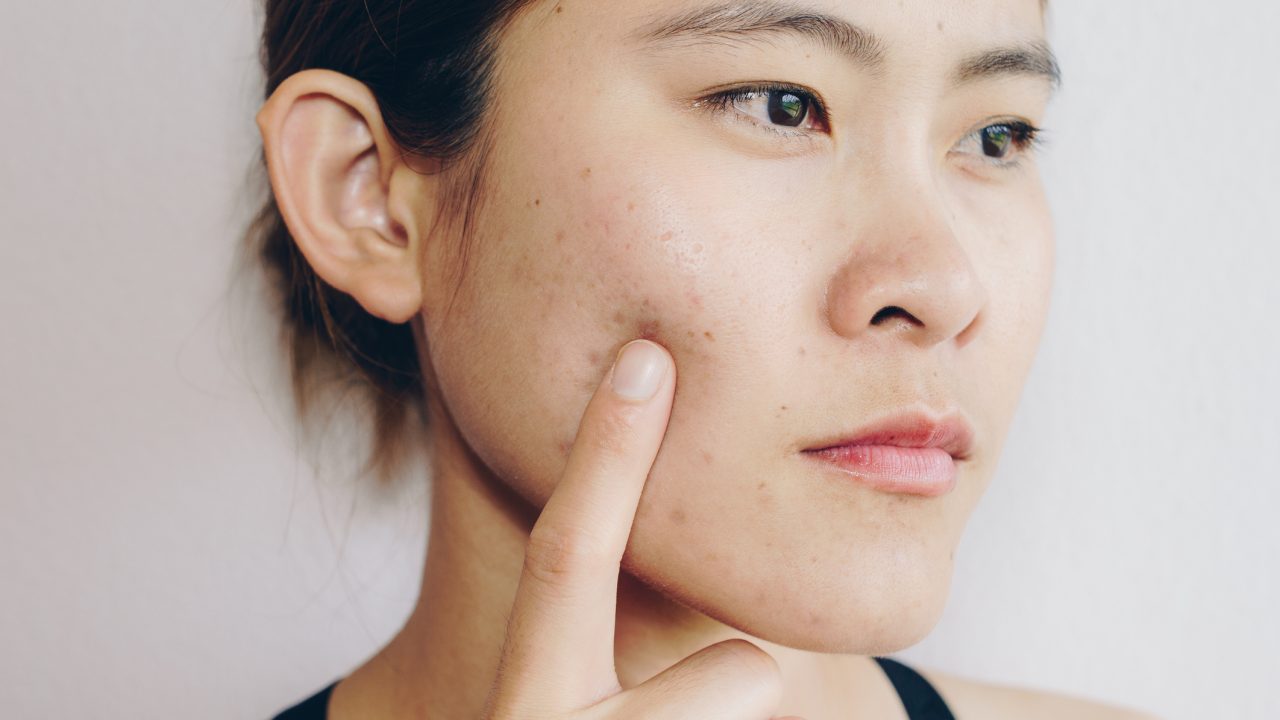
Acne is much more common than you might think and what causes acne, particularly adult acne, is more complex than just face being dirty.
According to research from Wake Forest Baptist Medical Center, in North Carolina, four out of five of us have experienced a form of acne at some point. There is no known prevention, nor is there a complete cure, but there are acne treatment options that can help get rid of acne and acne scars.
READ NEXT: How to get rid of spots fast
Below we explain what causes acne, what to do to lessen the impact, and which ingredients to look out for when buying skincare and makeup that can help get rid of acne.
Technically, there isn’t a difference between spots and acne, and defining exactly what acne is, is a little tricky.
Certain strains of bacteria, like Propionibacterium acnes, are known to cause acne in some people, but not others. These bacteria become trapped in the skin and cause inflammation, which is why some people with acne have painful or hot skin to the touch.
READ NEXT: Perfect your skincare routine with these must-have facial products
There are then six types of spots that can be symptoms of acne:
Each of these can appear on the face, back or chest, but the face is the most common. If you’re suffering from back acne, our sister site MBman has a guide on how to get rid of it.
Pustule Acne is noticeable by its white, pimple-like bumps, whereas Cystic Acne is the kind that sits underneath the skin. It will be sore, hard, and inflamed. Knowing which types of spots you have will determine which products will work best for you.
“Salicylic acid is great for treating cystic acne as its an anti-inflammatory and anti-bacterial whereas glycolic acid is great for pustules. It’s also common to have more than one type, in which case a combination of active ingredients is best,” skin specialist, medical aesthetician, and founder of bea Skin Care, Bianca Estelle told mamabella.
Acne happens mostly during puberty because of changing hormone levels, but some people can be genetically predisposed to having acne too.
Certain hormones can cause the glands in your skin to produce more sebum than usual, and this is why some women get breakouts around the time of their period, or during pregnancy.
What’s more, if your parents have/had acne, it increases your chances of getting it. Around 3% of people over 35 have acne.
FURTHER READING: How your skin changes in each decade of your life – and what to do about it
Your skin contains hair follicles that produce an oily substance called sebum. It’s the stuff that makes your skin oily or hair greasy and is necessary – in appropriate amounts – to keep both moisturised. It’s only when too much is produced (or too little) that people start running into problems.
These follicles are found at the opening of pores, so it’s easy for these pores to become clogged with dead skin cells, dirt, and particularly bacteria. This is what causes blackheads, whiteheads, and other kinds of spots.
Clogged pores are one of the main causes of acne – or at least, they make acne worse.
Because acne is related to excess sebum, using products that remove this oily substance and unclog pores can help. Any makeup or skincare products aimed at oily skin will likely have a positive effect on acne-prone skin.
“Use a combination of AHAs (Alpha Hydroxy Acids) and BHAs (Beta Hydroxy Acids) to target different layers of the skin,” added Bianca. “AHA’s include glycolic acid and lactic acid whereas salicylic acid is a BHA.”If your skin is on the sensitive side, opt for lactic acid. Lactic acid is like glycolic acid, but it has a larger molecule size that penetrates the skin at a slower rate and is, therefore, less aggressive.”
FURTHER READING: Skincare ingredient checker: Get to grips with what’s in your skincare with our ingredients guide
It’s important to keep moisturising your skin, even if you think adding more products or oil will make things worse. Also, remember to exfoliate the skin and to use products that are non-comedogenic. We explain more about this in our ‘What does non comedogenic mean?’ guide, as well as in our truth about the acids you’re putting on your skin explainer.
According to the NHS, products with a low concentration of benzoyl peroxide may be recommended by a pharmacist, but as the word ‘peroxide’ would suggest, this does contain bleach which can be harsh.
People with severe acne might also need help from a doctor. They can be treated using antibiotics, hormone regulators, or a drug called isotretinoin. The most common form of which is known as Roaccutane.
These don’t work for everyone and should only be taken after seeking medical advice because there may be side effects that need to be managed. These should ideally be used you’ve attempted to relieve the symptoms cosmetically first.
READ NEXT: Best foundation for oily skin
Although it might be tempting to squeeze the spots or clean your skin frequently to stop acne, doing both can actually make it worse.
As Bianca continued: “Not only can [picking] push bacteria into the skin and surrounding areas, you also risk infection and scarring. Post-inflammatory pigmentation (PIP) is common with acne sufferers and picking can make this worse, lengthening the time it takes to clear.”
Similarly, “don’t use coconut oil. This natural wonder is fantastic for many things and is still widely used today, but please don’t use it to remove makeup or as a facial oil. It’s highly comedogenic and will block pores, which is exactly what you don’t want when suffering from acne.”
While there is no known cure for acne (yet), a paper published in 2018 showed the first steps towards creating a vaccine against acne.
For the first time, the team was able to show a reduction in inflammation using a vaccine.
“Once validated by a large-scale clinical trial, the potential impact of our findings is huge for the hundreds of millions of individuals suffering from acne vulgaris,” Chun-Ming Huang, from the University of California, San Diego, said at the time.
There are also peels and light therapy options people can choose to help get rid of acne – and its associated scarring and pigmentation – for good.
“For someone with a combination of cystic and pustule acne, I’d generally opt for blue LED therapy alongside glycolic acid/salicylic acid treatments,” added Biance. “Once acne is under control, a Jessner chemical peel can be introduced to address scarring and post-inflammatory pigmentation (PIP).”

Abigail is a leading science journalist writing about space, sustainability, technology and culture. She is author of The Art of Urban Astronomy, a must-have guide to the night sky that guides you through the seasons and learn about the brightest stars and constellations, the myths and legends of astronomy and how to identify star clusters and galaxies.
